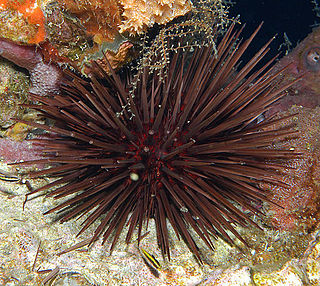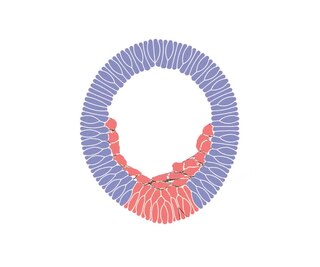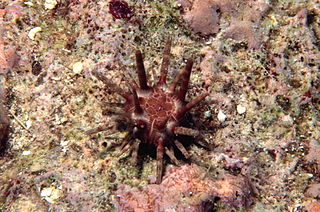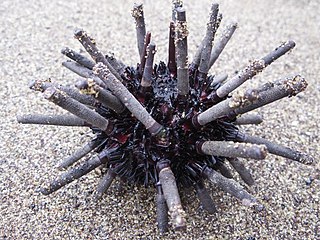
Hemichordata is a phylum which consists of triploblastic, eucoelomate, and bilaterally symmetrical marine deuterostome animals, generally considered the sister group of the echinoderms. They appear in the Lower or Middle Cambrian and include two main classes: Enteropneusta, and Pterobranchia. A third class, Planctosphaeroidea, is known only from the larva of a single species, Planctosphaera pelagica. The class Graptolithina, formerly considered extinct, is now placed within the pterobranchs, represented by a single living genus Rhabdopleura.

Sea urchins or urchins are typically spiny, globular animals, echinoderms in the class Echinoidea. About 950 species live on the seabed, inhabiting all oceans and depth zones from the intertidal to 5,000 metres. Their tests are round and spiny, typically from 3 to 10 cm across. Sea urchins move slowly, crawling with their tube feet, and sometimes pushing themselves with their spines. They feed primarily on algae but also eat slow-moving or sessile animals. Their predators include sea otters, starfish, wolf eels, and triggerfish.

Gastrulation is the stage in the early embryonic development of most animals, during which the blastula, or in mammals the blastocyst, is reorganized into a two-layered or three-layered embryo known as the gastrula. Before gastrulation, the embryo is a continuous epithelial sheet of cells; by the end of gastrulation, the embryo has begun differentiation to establish distinct cell lineages, set up the basic axes of the body, and internalized one or more cell types including the prospective gut.

The blastocoel, also spelled blastocoele and blastocele, and also called cleavage cavity, or segmentation cavity is a fluid-filled or yolk-filled cavity that forms in the blastula during very early embryonic development. At this stage in mammals the blastula is called the blastocyst, which consists of an outer epithelium, the trophectoderm, enveloping the inner cell mass and the blastocoel.

In amniote embryonic development, the epiblast is one of two distinct cell layers arising from the inner cell mass in the mammalian blastocyst, or from the blastula in reptiles and birds, the other layer is the hypoblast. It drives the embryo proper through its differentiation into the three primary germ layers, ectoderm, mesoderm and endoderm, during gastrulation. The amniotic ectoderm and extraembryonic mesoderm also originate from the epiblast.

Mesenchyme is a type of loosely organized animal embryonic connective tissue of undifferentiated cells that give rise to most tissues, such as skin, blood or bone. The interactions between mesenchyme and epithelium help to form nearly every organ in the developing embryo.
In the field of developmental biology, regional differentiation is the process by which different areas are identified in the development of the early embryo. The process by which the cells become specified differs between organisms.
Susan G. Ernst is professor emerita at Tufts University known for her work on cell development using sea urchins as a model system. She is an elected fellow of the American Association for the Advancement of Science.

Arvoredo Marine Biological Reserve is a Biological reserve off the coast of the Santa Catarina state, Brazil.

The Atlantic purple sea urchin is a species of sea urchins from the family Arbaciidae, native to the Atlantic Ocean.

Heterocentrotus mamillatus, commonly known as the slate pencil urchin, red slate pencil urchin, or red pencil urchin, is a species of tropical sea urchin from the Indo-Pacific region.

Ingression is one of the many changes in the location or relative position of cells that takes place during the gastrulation stage of embryonic development. It produces an animal's mesenchymal cells at the onset of gastrulation. During the epithelial–mesenchymal transition (EMT), the primary mesenchyme cells (PMCs) detach from the epithelium and become internalized mesenchyme cells that can migrate freely.
Skeletogenesis is a key morphogenetic event in the embryonic development of vertebrates and is of equal, although transient, importance in the development of the sea urchin, a marine invertebrate. The larval sea urchin does not resemble its adult form, because the sea urchin is an indirect developer, meaning its larva form must undergo metamorphosis to form the juvenile adult. Here, the focus is on skeletogenesis in the sea urchin species Strongylocentrotus purpuratus, as this species has been most thoroughly studied and characterized.

Cidaridae is a family of sea urchins in the order Cidaroida.

Eucidaris is a genus of cidaroid sea urchins known as slate pencil urchins. They are characterised by a moderately thick test, a usually monocyclic apical disc, perforate and non-crenulate tubercles and nearly straight ambulacra with horizontal pore pairs. The primary spines are few and widely spaced, stout with blunt flat tips and beaded ornamentation and the secondary spines are short and apressed. They originated in the Miocene and extant members of the genus are found in the tropical Indo-Pacific Ocean, East Pacific, Atlantic Ocean and Caribbean Sea.

Eucidaris metularia, the ten-lined urchin, is a species of sea urchins in the family Cidaridae. It is found in shallow parts of the Indo-Pacific Ocean and is characterised by its sparse covering of banded, flat-tipped spines.

Eucidaris thouarsii, the slate pencil urchin, is a species of cidaroid sea urchins that inhabits littoral regions of the East Pacific Ocean.
Sabinella troglodytes is a species of small sea snail, a marine gastropod mollusk in the family Eulimidae. It is a parasitic snail found near the coast of Brazil which lives on the body of the slate pencil urchin Eucidaris tribuloides.

Eucidaris galapagensis, commonly referred to as the slate pencil sea urchin, is a species of echinoderms in the family of Cidaroid. This sea urchin lives in coastal areas in the Galapagos, Clipperton, and Cocos. The preferred substrate of these organisms is rocky, benthic environments that provide refuge. In fact, greater abundance of Slate Pencil Sea Urchins is correlated with correct substrate, as well as greater food availability. Their diet is primarily herbivorous, however, they also consume various invertebrates. They graze heavily on live corals and algae in open, shallow reef habitats. Their grazing schedule is not restricted to sunlight availability, and will graze nocturnally. Their diversity in diet is a result of their metabolism, as they are capable of remarkably efficient assimilation of nutrients. Pencil Slate Sea Urchin's crawl omnidirectionally in their environment. Additionally, they are able to sense surrounding light by photoreceptor cells that act as their visual system.


















